Lucy Stone Worksheets
Do you want to save dozens of hours in time? Get your evenings and weekends back? Be able to teach about Lucy Stone to your students?
Our worksheet bundle includes a fact file and printable worksheets and student activities. Perfect for both the classroom and homeschooling!
Resource Examples
Click any of the example images below to view a larger version.
Fact File
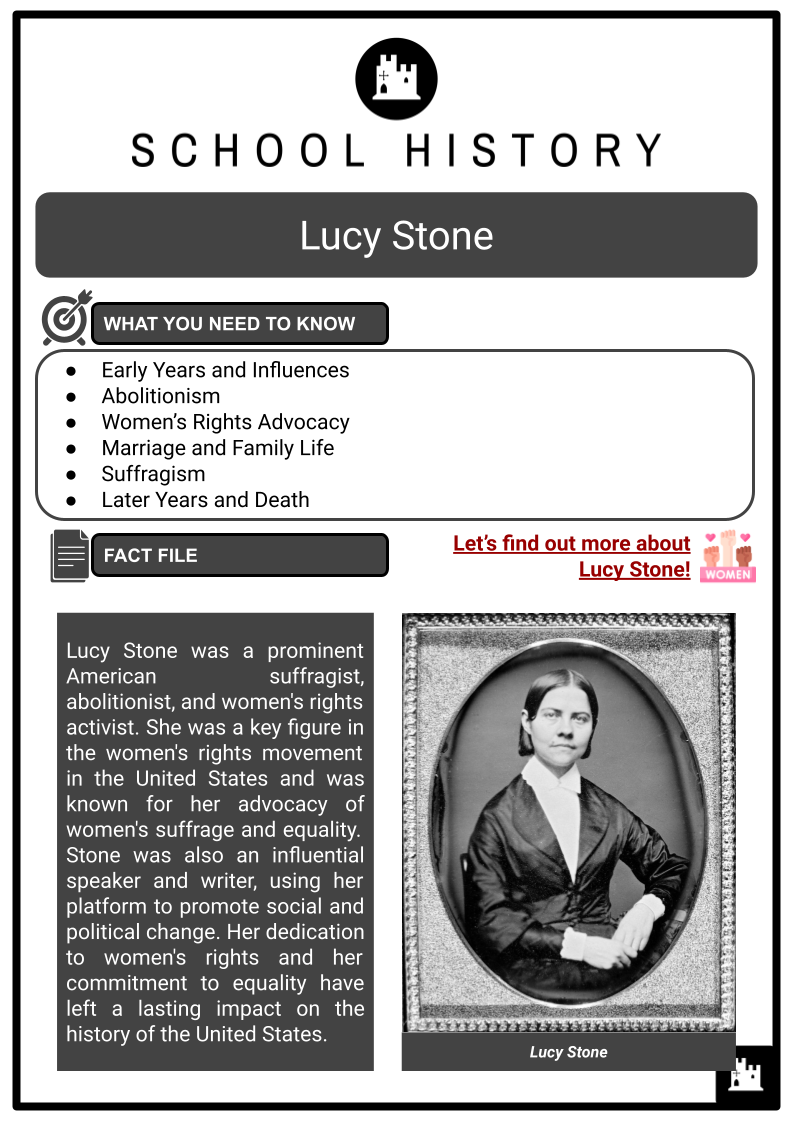
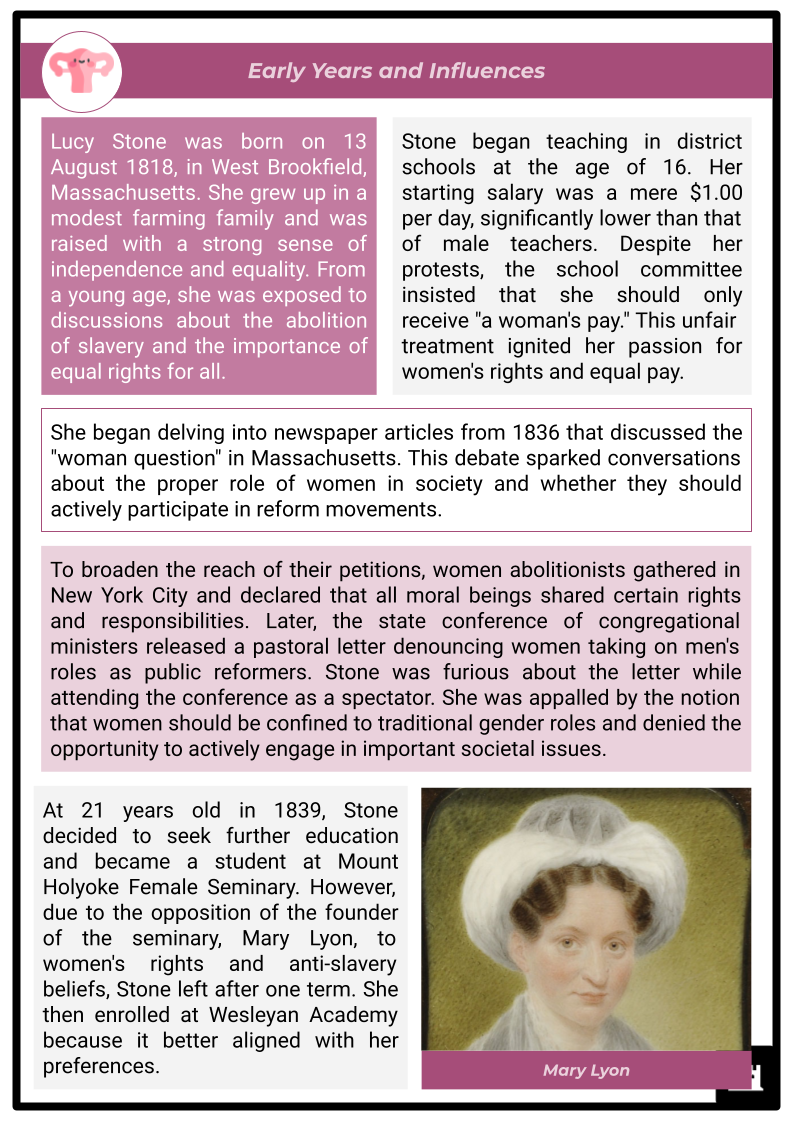
Student Activities
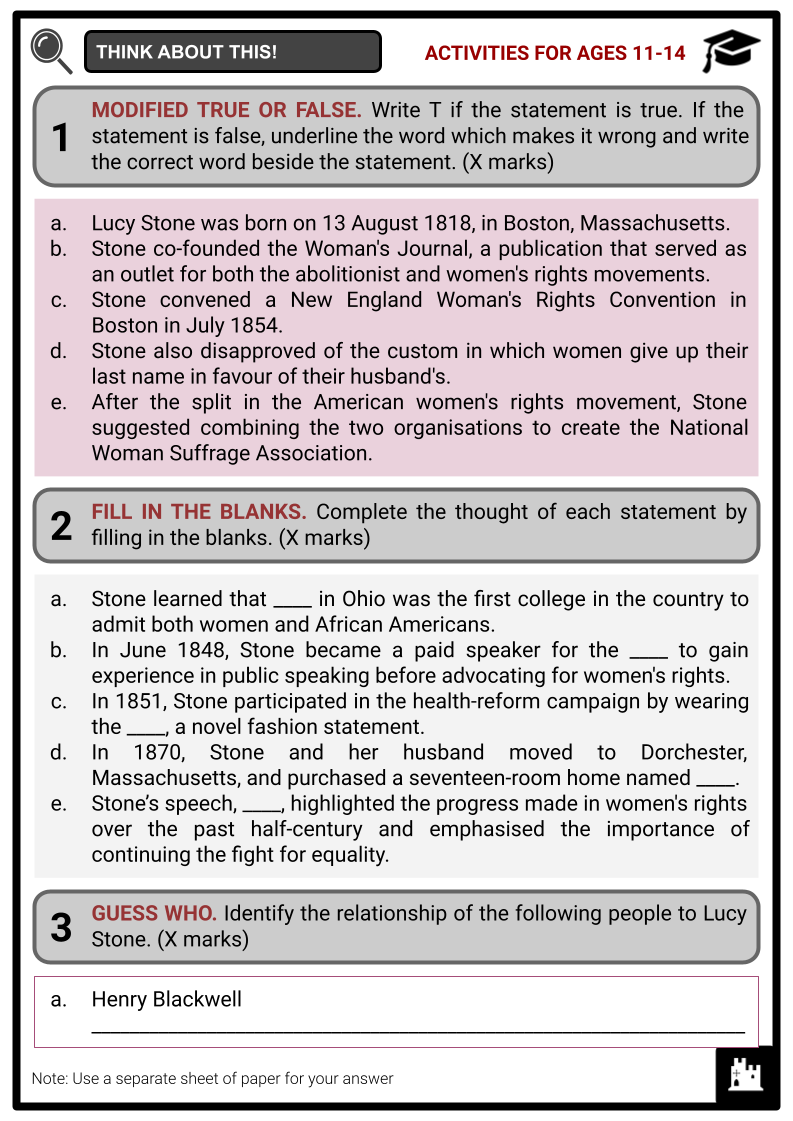
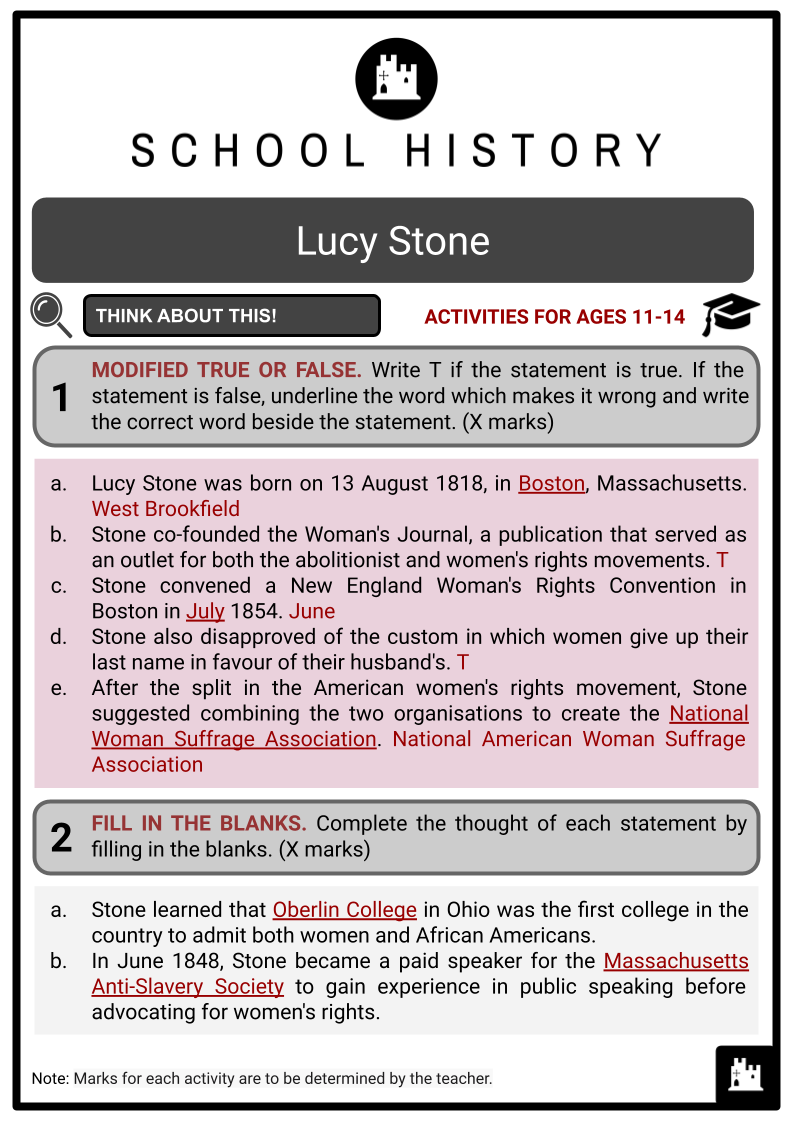
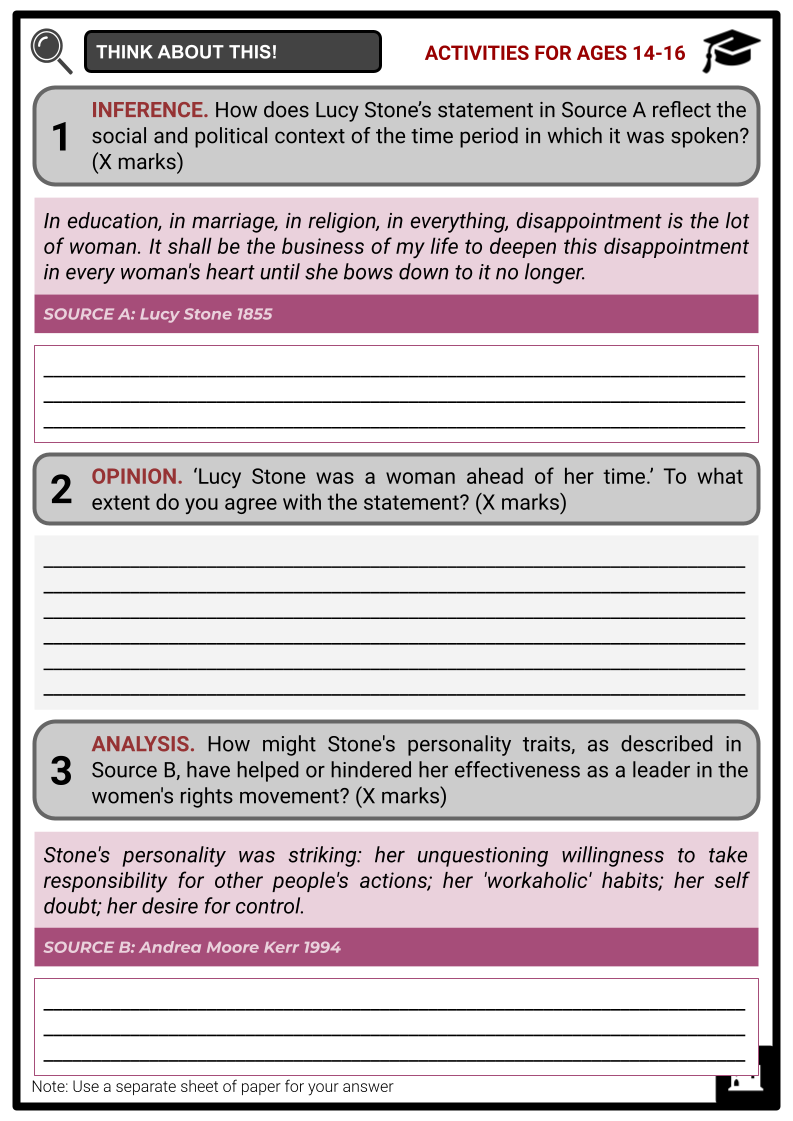
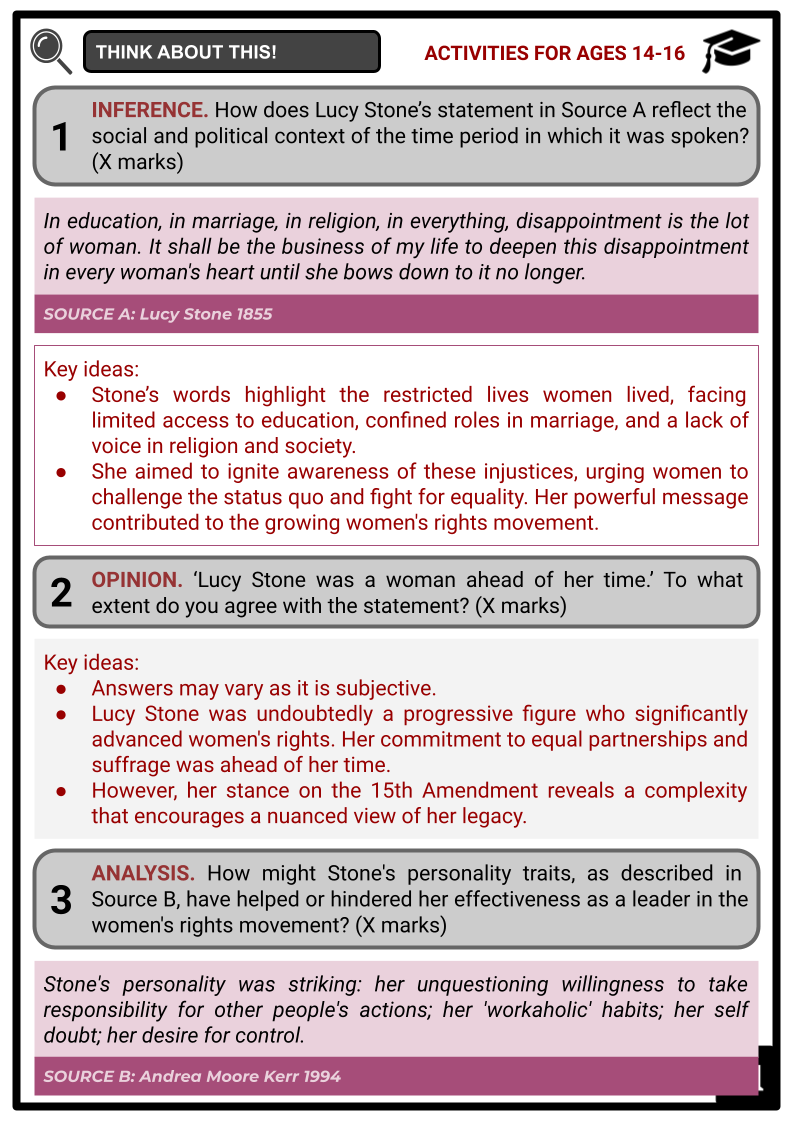
Summary
- Early Years and Influences
- Abolitionism
- Women’s Rights Advocacy
- Marriage and Family Life
- Suffragism
- Later Years and Death
Key Facts And Information
Let’s find out more about Lucy Stone!
Lucy Stone was a prominent American suffragist, abolitionist, and women's rights activist. She was a key figure in the women's rights movement in the United States and was known for her advocacy of women's suffrage and equality. Stone was also an influential speaker and writer, using her platform to promote social and political change. Her dedication to women's rights and her commitment to equality have left a lasting impact on the history of the United States.
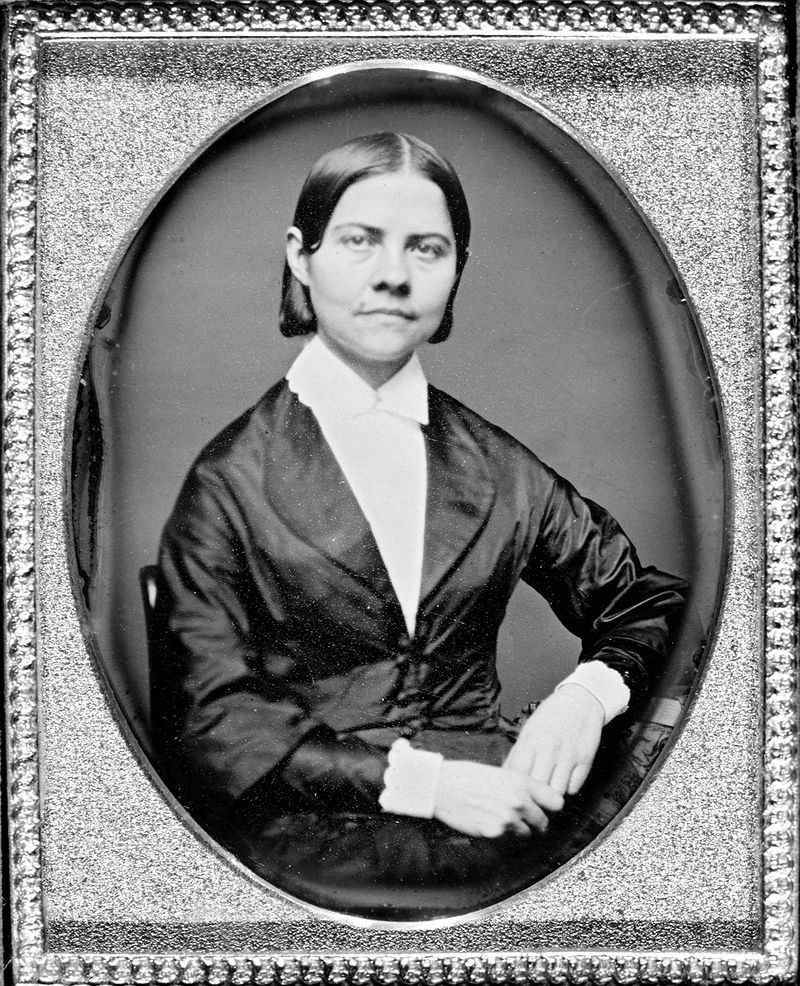
Early Years and Influences
- Lucy Stone was born on 13 August 1818, in West Brookfield, Massachusetts. She grew up in a modest farming family and was raised with a strong sense of independence and equality. From a young age, she was exposed to discussions about the abolition of slavery and the importance of equal rights for all.
- Stone began teaching in district schools at the age of 16. Her starting salary was a mere $1.00 per day, significantly lower than that of male teachers. Despite her protests, the school committee insisted that she should only receive "a woman's pay." This unfair treatment ignited her passion for women's rights and equal pay.
- She began delving into newspaper articles from 1836 that discussed the "woman question" in Massachusetts. This debate sparked conversations about the proper role of women in society and whether they should actively participate in reform movements.
- To broaden the reach of their petitions, women abolitionists gathered in New York City and declared that all moral beings shared certain rights and responsibilities. Later, the state conference of congregational ministers released a pastoral letter denouncing women taking on men's roles as public reformers. Stone was furious about the letter while attending the conference as a spectator. She was appalled by the notion that women should be confined to traditional gender roles and denied the opportunity to actively engage in important societal issues.
- At 21 years old in 1839, Stone decided to seek further education and became a student at Mount Holyoke Female Seminary. However, due to the opposition of the founder of the seminary, Mary Lyon, to women's rights and anti-slavery beliefs, Stone left after one term. She then enrolled at Wesleyan Academy because it better aligned with her preferences.
- After reading about Abby Kelley in the media, Stone chose to follow her example three years later. Kelley had stood firm in defending her right to speak freely and to vote. When a deacon was banished from Stone's church in 1843 due to his antislavery actions, Stone extended her hand in support of Kelley.
- After the initial vote for the deacon’s removal, Stone showed her solidarity by raising her hand. Despite being a church member, the minister dismissed her vote on the grounds that she was not eligible to participate. Undeterred, like Kelley, she continued to raise her hand in defiance for the subsequent five votes.
- After a year at the coeducational Monson Academy, Stone learned that Oberlin College in Ohio was the first college in the country to admit both women and African Americans. To prepare for the entrance exams at Oberlin, she enrolled at Quaboag Seminary in Warren, studying Latin and Greek grammar. In August 1843, at the age of 25, Stone began attending Oberlin College.
- As Stone matured into a young adult, she began to question the societal norms that limited women's opportunities and rights. Exposure to early feminist thinkers strengthened her commitment to women's rights and resolve to drive change.
- For instance, the writings of the English author and proponent of women's equality, Mary Wollstonecraft, had a significant influence on her. Wollstonecraft's seminal work, "A Vindication of the Rights of Woman," challenged the prevailing norms and argued for women's education and political rights. Stone found inspiration in Wollstonecraft's ideas and her call for women to be regarded as rational beings deserving of the same rights and opportunities as men.
- Additionally, Stone's correspondence with Angelina and Sarah Grimké, renowned abolitionists and early feminist writers, provided her with valuable insights into the systematic oppression of women and the interconnectedness of various social justice causes. The Grimké sisters' writings on women's rights deeply resonated with Stone and reinforced her determination to challenge gender-based discrimination.
Abolitionism
- Stone's commitment to the abolitionist cause was closely connected to her support for women's rights. As she explored the injustices of slavery, she saw the similar challenges experienced by women in a male-dominated society. She argued that the struggle against slavery and the push for women's rights were linked, both grounded in the belief in equal treatment for everyone.
- In June 1848, she became a paid speaker for the Massachusetts Anti-Slavery Society to gain experience in public speaking before advocating for women's rights. She spoke at women's rights conventions in Seneca Falls and Rochester and received support from progressive reformers in the Garrisonian wing of the abolitionist movement. In April 1849, she was invited to speak by the Philadelphia Female Anti-Slavery Society. She spearheaded petition drives for women's suffrage and the right to run for public office with backing from abolitionists.
- Stone travelled extensively, delivering powerful speeches that garnered attention and support for the abolitionist cause. She passionately argued for the immediate freedom of enslaved people and equal rights for all, regardless of race or gender.
- As a prominent figure within the abolitionist movement, she worked closely with William Lloyd Garrison, the renowned abolitionist and publisher of "The Liberator." Garrison's fervent advocacy for the immediate and unconditional emancipation of enslaved individuals resonated with Stone's beliefs, and together, they campaigned for the abolition of slavery.
- Additionally, Stone's collaboration with Frederick Douglass, a prominent African American abolitionist, expanded the reach and impact of her advocacy. Douglass promoted the rights and liberation of enslaved people in alignment with Stone's convictions, and their partnership greatly strengthened the abolitionist movement's efforts to effect social and political change.
- In 1850, Stone co-founded the Woman's Journal, a publication that served as an outlet for both the abolitionist and women's rights movements. The newspaper provided a space for her to advocate for the equality of women and to denounce the inequalities perpetuated by a society that condoned both slavery and the subjugation of women.
- In her anti-slavery writings, Stone attacked West Brookfield's First Congregational Church as well as other churches that refused to oppose slavery. She was banished from the church in 1851. After talking with Abby Kelley at Oberlin, she later converted to Unitarianism.
Women’s Rights Advocacy
- As Stone continued her activism, she became a leading voice in the fight for women's rights. In 1850, she and Paulina Wright Davis coordinated a national convention for women's rights with the help of abolitionists. The inaugural National Women's Rights Convention took place in Worcester, Massachusetts, on 23-24 October.
- In 1851, Stone participated in the health-reform campaign by wearing the Bloomer dress, a novel fashion statement. The outfit consisted of an airy blazer, oversized pants, and a knee-length skirt. It was a response to the Water-Cure Journal's request for women to embrace a style that would allow them to use their legs freely. The Bloomer quickly gained popularity in the following months, with women from Toledo to New York City and Lowell, Massachusetts, organising reform-dress social events and festivals.
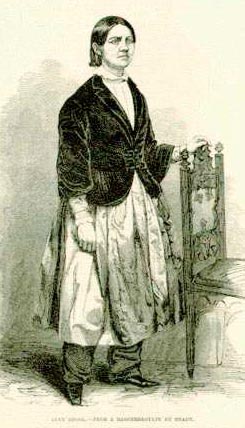
- Before being married herself, Stone thought that wives should be able to file for divorce from intoxicated husbands in order to put an end to a "loveless marriage" and give the wounded party's soul time to heal from their wounds. She held that unadulterated, holy love is entitled to recognition and shouldn't be withheld.
- Following the National Woman’s Rights Convention in Cleveland, Ohio, in 1853, Lucretia Mott and Stone, an abolitionist, spoke at Cincinnati’s first women’s rights meeting.
- Henry Blackwell, a local businessman, organised this event because of his interest in Stone. After the meeting, she accepted his offer to arrange a lecture tour for her in the western states. In thirteen weeks, she delivered almost forty lectures across thirteen different cities.
- Not only was Stone a well-known spokesman for the women's rights movement, but she also spearheaded its petitioning activities. She started petition campaigns in New England and a few other states, and she supported state and local groups in New York, Ohio, and Indiana in their petitioning endeavours.
- Between 1849 and 1852, Stone petitioned the Massachusetts legislature for women's voting and public office rights. She collected more than 5,000 signatures for the convention after nine months of statewide canvassing. To intensify her petitioning, she convened a New England Woman's Rights Convention in Boston in June 1854. She referred to the ballot as the "woman's sword and shield" and urged women to pursue suffrage in order to preserve any advances made.
Marriage and Family Life
- In 1853, Stone engaged in a two-year courtship with Henry Blackwell, a prominent abolitionist and advocate for women’s rights. Initially, Stone resisted marriage because she desired independence and did not want the legal status of a married woman. Blackwell, on the other hand, believed that by working as a couple, they could form an equal partnership, protect the woman from unjust laws, and enhance each other's individual achievements. Ultimately, in 1855, the two were married.
- Stone and Blackwell’s union was considered unconventional for its time, as they both agreed to omit the word "obey" from their wedding vows, signifying their commitment to an equal partnership. This decision was reflective of their belief in the inherent equality of both spouses within a marriage, a principle that extended to their wider advocacy for women's rights.
- Stone also disapproved of the custom in which women give up their last name in favour of their husband's. She signed letters as "Lucy Stone" or "Lucy Stone-only" even after she got married. She did, however, write her name as Lucy Stone Blackwell on official documents for eight months after a property registrar requested she do so.
- To maintain and safeguard Stone's financial independence and personal freedom, Stone and Blackwell crafted a confidential agreement. They consented to handle their marriage like a business partnership, sharing profits but giving up ownership of each other's profits in the event of a divorce. They also decided to keep their own autonomy and independence.
- In the face of prevailing societal norms, Stone and Blackwell’s union became a model for egalitarian relationships and challenged traditional gender roles. The birth of their daughter, Alice Stone Blackwell, in 1857 further solidified their bond as a family rooted in activism and progressive ideals. Throughout her marriage and while raising her daughter, Stone continued to support women's voices and advocate for their inclusion in social and political spheres.
Suffragism
- In 1870, Stone and her husband moved to Dorchester, Massachusetts, and purchased a seventeen-room home named Pope's Hill. They were involved in the Dorchester Female Anti-Slavery Society, and by 1870, many local women supported suffrage.
- Despite her significant contributions to the women's rights movement, however, Stone later found herself at odds with some other leading feminists of the time. One of the key points of contention was the issue of suffrage for African American men. Stone, along with her husband, supported the 15th Amendment, which sought to extend voting rights to African American men.
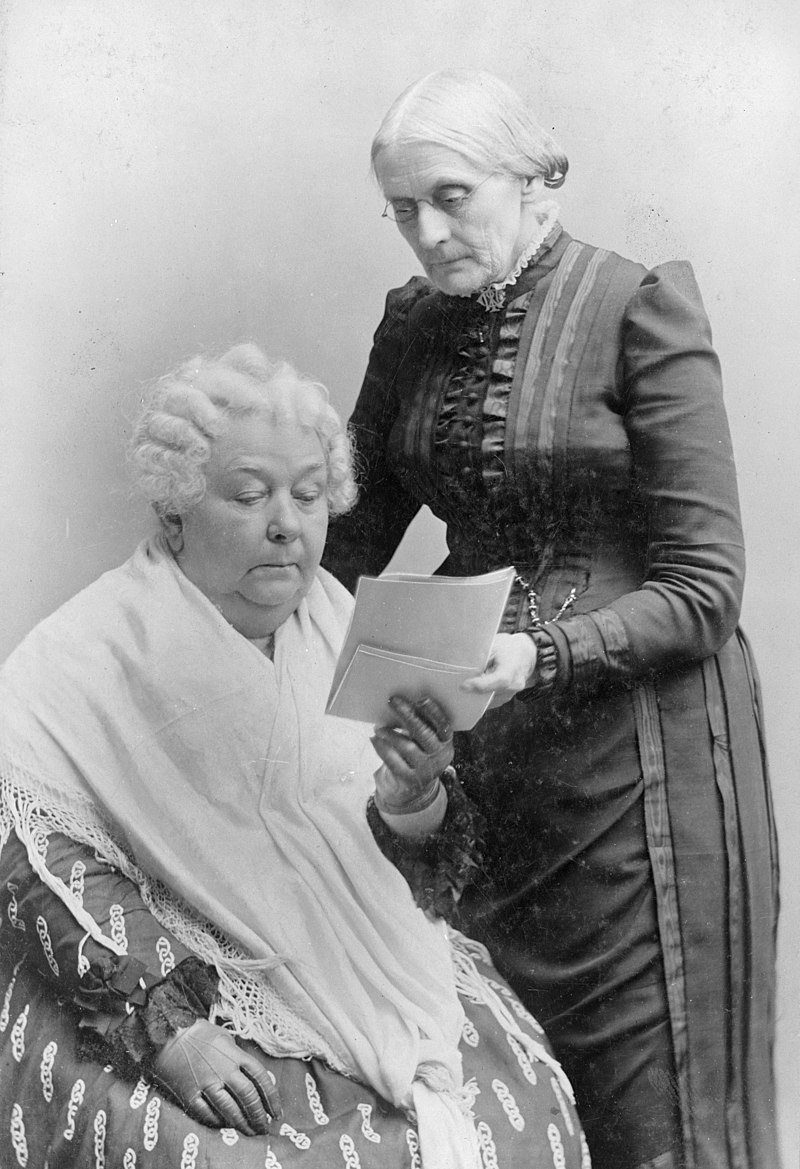
- However, this position led to a fracture within the women's movement, as some suffragists, including Elizabeth Cady Stanton and Susan B. Anthony, opposed the amendment because it did not also include women. This division ultimately led to the split between the suffragists, with Stone becoming a leading figure in the American Woman Suffrage Association (AWSA), while Stanton and Anthony formed the competing National Woman Suffrage Association (NWSA).
- The AWSA was dedicated to advocating for women's voting rights and equal representation in government. Through it, Stone collaborated with other prominent suffragists to advance the cause of women's suffrage through grassroots organising, public lectures, and strategic advocacy efforts.
- After the split in the American women's rights movement, Stone suggested combining the two organisations to create the National American Woman Suffrage Association (NAWSA) in 1890. Stanton was chosen as president, Anthony as vice president, and Stone as chair of the executive committee.
Later Years and Death
- Stone delivered her final public address at the World's Congress of Representative Women during the 1893 World's Columbian Exposition in Chicago. Her speech, "The Progress of Fifty Years," highlighted the progress made in women's rights over the past half-century and emphasised the importance of continuing the fight for equality.
- At the age of 75, Stone was diagnosed with severe stomach cancer and became too ill to continue attending meetings for her cause. She penned her last letters to loved ones and friends before passing away on 18 October 1893.
- One hundred people came to her funeral, and six women and six men carried her coffin. Up to that point, Stone's death had received the greatest media coverage of any American woman. She became the first person in Massachusetts to be cremated when her body was handled in accordance with her desires.
Legacy of Lucy Stone:
- Pioneering Advocate for Women's Suffrage: Stone devoted her life to advocating for women's suffrage, playing a pivotal role in the movement’s growth and ultimately witnessing its success.
- Champion of Equal Partnerships: Her unconventional marriage to Henry Blackwell challenged societal norms and provided a model for egalitarian relationships based on mutual respect and shared goals.
- Skilled Organiser and Strategist: Stone's talent for mobilising supporters, organising campaigns, and petitioning legislatures significantly advanced the cause of women's rights.
- Powerful Voice for Equality: Stone was a talented speaker and writer who effectively spoke out against injustices faced by women, inspiring many to join the fight for equality.
Image Sources
- https://upload.wikimedia.org/wikipedia/commons/thumb/d/df/Sm_lucy_stone_3d02055r.jpg/800px-Sm_lucy_stone_3d02055r.jpg
- https://upload.wikimedia.org/wikipedia/commons/a/a1/Lucy_Stone_in_bloomers.jpg
- https://upload.wikimedia.org/wikipedia/commons/thumb/5/55/Elizabeth_Cady_Stanton_and_Susan_B_Anthony.jpg/800px-Elizabeth_Cady_Stanton_and_Susan_B_Anthony.jpg
Frequently Asked Questions
- Who was Lucy Stone?
Lucy Stone (1818-1893) was an American orator, abolitionist, and a vocal advocate for women's rights. She was among the first women in the United States to earn a college degree.
- What are some of Lucy Stone's major accomplishments?
In 1850, she helped organise the first National Women's Rights Convention. She was also a founder of the American Woman Suffrage Association (AWSA) and started the influential women's rights newspaper The Woman's Journal.
- Did Lucy Stone work with other famous women's rights activists?
Yes, Lucy Stone collaborated with other prominent activists like Susan B. Anthony and Elizabeth Cady Stanton. However, she had differing views on specific issues, which led to the formation of different organisations within the movement.
